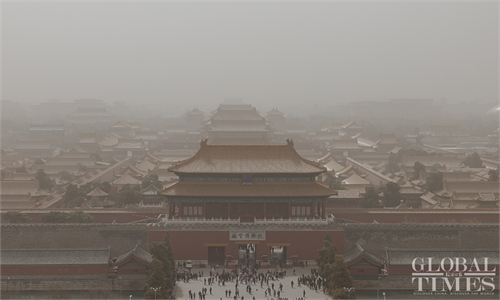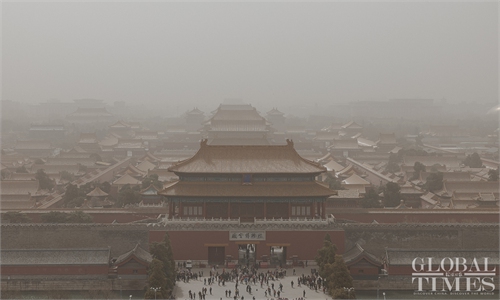
People in Hohhot, North China's Inner Mongolia Autonomous Region wrap scarves around their heads as the city is engulfed in sandstorms on April 10, 2023. Photo: IC
Following days of clear and bright weather, some parts of northern China once again are enveloped by sandstorms with the country's desertification monitoring center saying on Monday that the dusty weather originated in Mongolia and continued to move southeast along with the air flow after hitting parts of North China's Inner Mongolia Autonomous Region.
The National Meteorological Center (NMC) issued a blue alert for sandstorms, warning local residents that billowing dust is expected to hit more than a dozen provinces and regions in northern China.
Beijing's tourism authorities called for the closure of major outdoor amusement facilities to ensure people's safety, as the Beijing Meteorological Services upgraded its wind warning to yellow on Monday night. The strong winds in some places could reach force 10 and will last until Tuesday afternoon.
As of Monday at 8 pm, the air pollution index in Beijing stood at 272, meaning pollution level was severe, and the primary pollutant in the air was PM10.
Affected by cold air and strong gales, sand and dust are expected to hit parts of southern and eastern Xinjiang, the Qaidam Basin in Qinghai Province, western and northern Gansu, Ningxia, central and northern Shaanxi, Inner Mongolia, Shanxi, Hebei and Shandong, Beijing, Tianjin, northern Henan, southwestern Heilongjiang, central and western Jilin, and central and western Liaoning in the 24-hour period that started at 8 am on Monday.
The NMC added that the central and western areas of Inner Mongolia would be particularly affected. The dusty weather began to affect the central and western parts of Inner Mongolia from 10 am on Sunday.
Because of low pressure systems in Mongolia, a large area of dust has entered Mongolia and central parts of North China's Inner Mongolia, leading to the PM10 concentration in Northwest China increasing significantly, with some cities reaching the level of severe or serious pollution, the Beijing Ecological Environment Monitoring Center said on Sunday.
The process this time was weaker in intensity and scope than the strong sandstorm that developed from March 19 to 24, the NMC noted.
Zhang Mingying, a Beijing-based meteorologist, told the Global Times on Monday that last winter and this spring have seen less rain and snow than usual, which led to a more severe drought, thus making it easier for dust emissions in sand source areas.
Precipitation in sandy areas in southern Mongolia to central and western Inner Mongolia during this spring is expected to be below average, with the temperatures being higher than the same period in previous years and the Mongolia cyclone phase's southward influence, which is conducive to the formation of dust events, according to the China Meteorological Administration on March 25.
It is expected that from late April or early May with the weather warming up and rainfall increasing, the dusty weather would gradually ease, Zhang predicted.
According to the Ministry of Emergency Management and other authorities, in the first quarter, there were six sandstorm weather events, four of which occurred in March.
According to Caixin Media, at least five sandstorms have affected Beijing in 2023 one in January, three in March and one in April.
Northern China was hit by more sandstorms this March compared with previous years, the result of multiple factors including stronger winds generated by cold fronts, higher temperatures and poor vegetation coverage in the southern parts of Mongolia and northern China due to low precipitation, climate specialists said.
It is estimated that the number of dust events in northern China is higher than at any stage during the past decade, while the dust intensity is generally the same as in the past 10 years, the administration noted.
In recent years, vegetation has increased greatly in northern China, and the environment improved significantly, which is generally conducive to the gradual reduction of dust frequency.
However, the Gobi Desert in southern Mongolia is an important source of sand and dust affecting China. In the vegetation growing season of 2022, levels of precipitation in Mongolia were down on the average of the previous 20 years, vegetation coverage in sandy areas was poor, and bare surfaces lacked vegetation protection.
In addition, frequent dust events this year are mainly related to the recent abnormal atmospheric circulation, Caixin reported.
In the early spring of this year, the temperatures warmed significantly, especially in early March, which led to the rapid melting of the earlier permafrost sand soil.
Considering that March and April are usually the most windy months in the north, under strong wind conditions, sand dust from the sand source was transported to China, which is the most direct reason for the severe dust weather this year.




